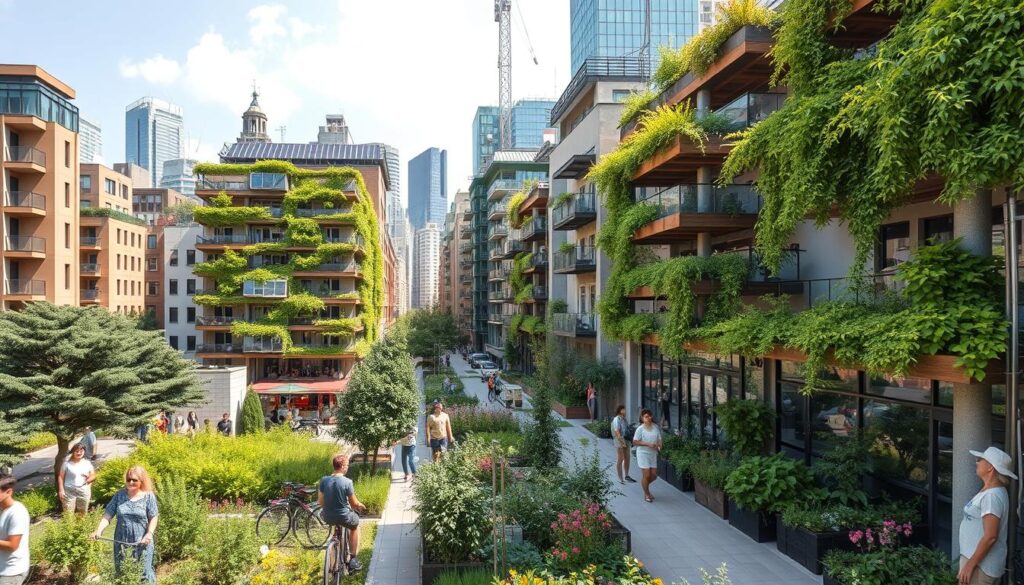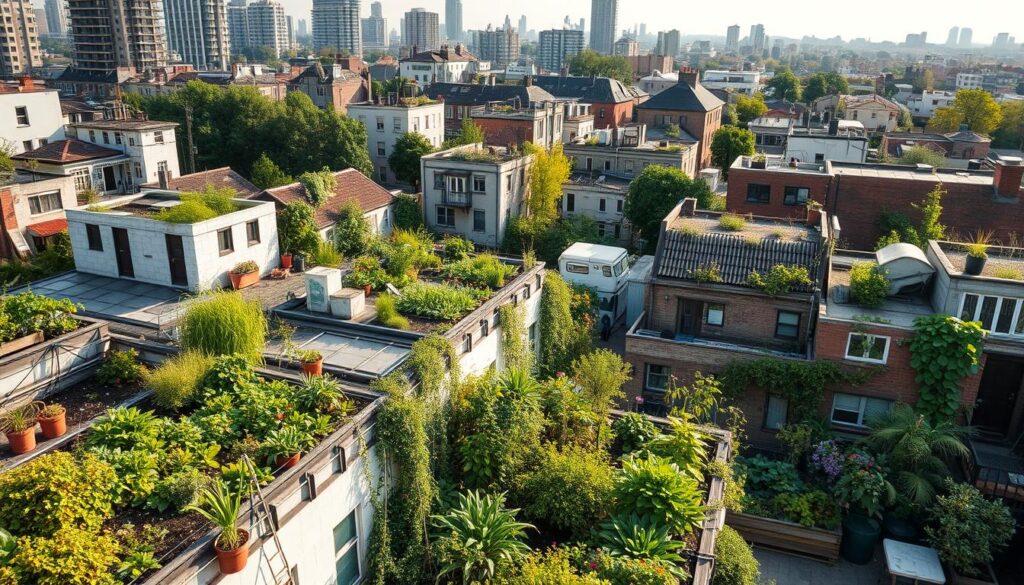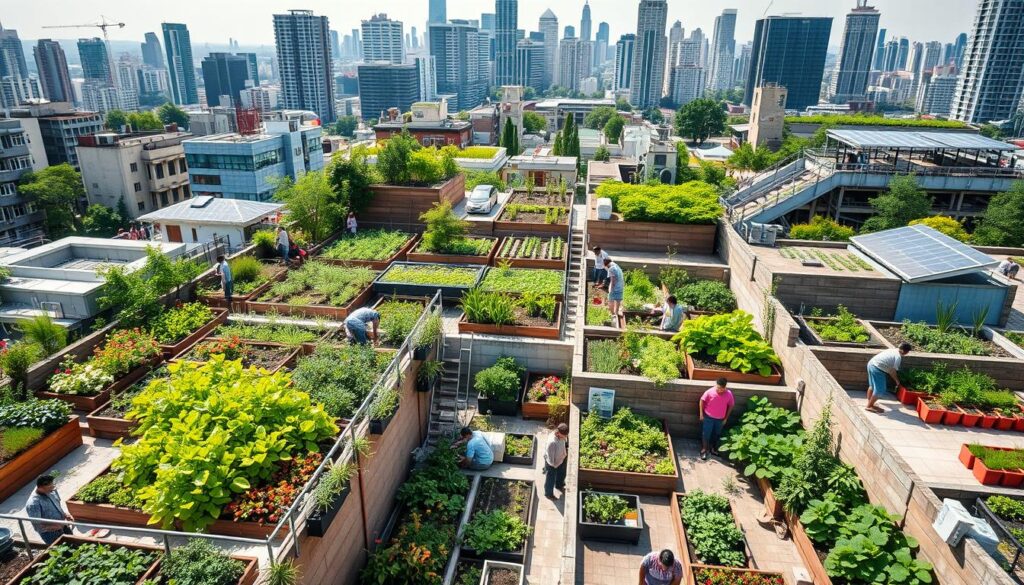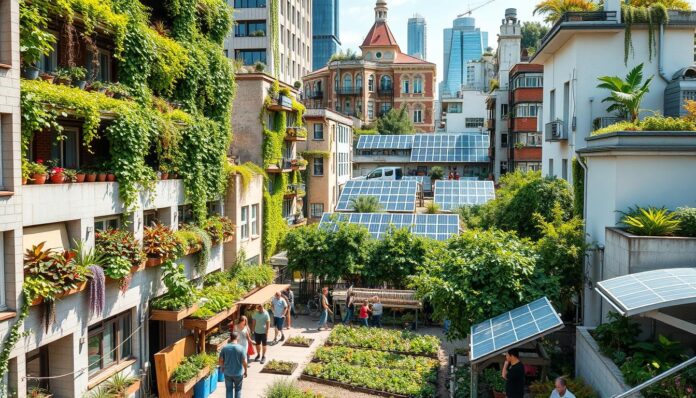Permaculture is a way to design sustainable human environments that work like nature. It helps us think better about how we interact with nature. This idea can make cities stronger and greener, which is key for a sustainable future.
By learning about permaculture in cities, policymakers can make better rules. These rules help the environment and the people living there.
Urban permaculture doesn’t need a lot of land. It shows that even in small spaces, we can make a big difference. Community gardens in cities show people want to live sustainably. This is where permaculture in urban planning comes in.
It aims to make cities better for everyone and the planet. This is important for a sustainable future.
Key Takeaways
- Permaculture is a design system for creating sustainable human environments that mimic beneficial relationships found in nature.
- Urban permaculture can be practiced without owning private property or large amounts of land, highlighting accessibility in urban settings.
- Permaculture urban policy aims to create sustainable and regenerative systems that can be applied to urban planning for sustainable urban development.
- Over 55% of the world’s population currently lives in urban areas, with projections to increase to 68% by 2050.
- Cities are responsible for approximately 70% of global carbon dioxide emissions, making sustainable urban development crucial.
- Permaculture principles can result in cost savings related to waste management and energy consumption by promoting resource-efficient design and local food production.
Understanding Permaculture in Urban Settings
Permaculture offers a complete solution to urban environmental problems. It uses nature’s ways to make urban areas efficient, productive, and sustainable. Urban permaculture projects focus on making cities better, even with little space and resources.
By combining city planning with permaculture, we can build stronger, greener cities. This approach includes reducing waste and boosting biodiversity in urban planning. Some key benefits for communities are:
- More urban biodiversity with a variety of plants and animals
- Less need for traditional farming and its carbon footprint
- More food for everyone through local gardens and support programs
Good urban permaculture also helps the air, saves water, and improves soil. Knowing the value of sustainability helps city leaders make better choices. They can support projects that use permaculture and make cities better for everyone.
The Role of Urban Policy in Sustainability
Cities are responsible for about 70% of global carbon dioxide emissions. They also use over 60% of resources, as stated by the UN. This calls for urgent, sustainable solutions. Urban policymakers are key in promoting sustainability by creating and enforcing policies that lessen environmental harm and boost community health.
Urban sustainability guidelines are vital for tackling city environmental challenges. Policymakers can spot and fix policy weaknesses by evaluating environmental impacts. Also, managing urban ecosystems is crucial for balancing development with conservation.
Current Urban Policy Frameworks
Today’s urban policies mainly aim to cut carbon emissions and boost renewable energy. They also focus on better waste management. Yet, we need more all-encompassing policies that include ecosystem management and sustainability guidelines. A holistic approach that looks at social, economic, and environmental aspects is necessary.
Assessing Policy Impact on Urban Environments
It’s essential to check how urban policies affect the environment. This can be done by tracking indicators like carbon emissions, air quality, and waste management. Data and research help policymakers refine policies for better sustainability and ecosystem management.
- Creating green spaces like parks and green roofs
- Supporting renewable energy like solar and wind power
- Enhancing waste management through recycling and composting
- Encouraging eco-friendly transport like cycling and walking
By using these strategies, cities can lessen their environmental footprint and foster sustainable growth. Urban policymakers must collaborate with various stakeholders to craft and enforce policies that support sustainability and ecosystem management.
Integrating Permaculture with Urban Planning
The world is getting more urban, with over 55% of people living in cities. It’s crucial to use sustainable city policies and green urban planning. Permaculture, a design system, can help make cities into thriving ecosystems.
To mix permaculture with urban planning, we need community support, policy backing, and creative designs. Some ways to do this include:
- Creating community gardens and green spaces
- Implementing sustainable transportation systems
- Promoting eco-friendly building practices
Projects like the Incredible Edible Todmorden and the Beacon Food Forest in Seattle show what’s possible. They prove that urban farming and green planning can make cities better. By using sustainable policies and green planning, cities can cut down on pollution, improve air and water, and make people’s lives better.

| City | Permaculture Project | Outcome |
|---|---|---|
| Todmorden | Incredible Edible Todmorden | Transformed vacant lots into community gardens |
| Seattle | Beacon Food Forest | Created a 7-acre food forest with diverse plant offerings |
Community Engagement in Urban Policy
Community engagement is key for making good urban policies, like permaculture in cities. It helps ensure policies fit what the community needs. Tools like participatory budgeting and public forums help with this.
Shared urban farms and eco-projects bring people together. They make cities stronger, build friendships, and make neighborhoods look better. For example, community gardens give fresh food to locals. This cuts down on environmental harm from long-distance food transport.
Some examples of working together in cities include:
- Community-led urban planning projects
- Participatory budgeting programs
- Public forums and town hall meetings
These efforts boost community involvement and green urban growth. They help permaculture thrive in cities.
By focusing on community and permaculture, cities can become greener and better places to live. It takes teamwork from policymakers, community members, and others to make a brighter future.
| Initiative | Benefits |
|---|---|
| Community gardens | Fresh produce, reduced transportation emissions |
| Participatory budgeting | Increased community engagement, more effective policymaking |
| Public forums | Improved communication, increased transparency |
Policy Challenges for Permaculture Implementation
Starting permaculture in cities faces many policy hurdles. Urban agriculture and permaculture policies are key to overcoming these. By-laws and zoning rules can block permaculture, so it’s vital for lawmakers to create supportive rules.
A study on permaculture under different political systems shows the need for regional self-reliance and redesigning infrastructure. This can help fight unsustainable choices and encourage green living.
Some major hurdles for permaculture include:
- Regulatory barriers, such as zoning laws and by-laws
- Lack of support for urban agriculture and green infrastructure
- Insufficient funding for permaculture projects
Yet, many cities are embracing permaculture, seeing big wins like lower carbon footprints and more food. For instance,  urban permaculture can cut household waste by 40% through composting and smart use of resources.
urban permaculture can cut household waste by 40% through composting and smart use of resources.
| Benefits of Permaculture | Percentage Improvement |
|---|---|
| Reduction in household waste | 40% |
| Decrease in water consumption | 50% |
| Increase in local biodiversity | 20% |
Economic Impacts of Permaculture in Cities
Permaculture brings big economic wins to cities. It creates jobs and saves money. Cities can cut down on waste and energy costs. Plus, it helps grow local food, making food more secure and reducing industrial farming needs.
Here are some key economic perks of permaculture in cities:
- Job creation through urban farming and green projects
- Cost savings from less waste and energy use
- More local food, cutting down on industrial farming and boosting food security
Urban planners can use cost-benefit analyses to choose the best permaculture projects. This supports sustainable urban development and urban ecosystem management. It makes cities stronger and more sustainable.
Urban Agriculture as a Permaculture Practice
Urban agriculture is key in permaculture, bringing many benefits to cities. It helps create sustainable food systems, cuts down on emissions, and boosts health. It also tackles food deserts by providing fresh food right in the city.
Permaculture uses perennial food systems to improve ecosystem health. Cities offer great chances for permaculture by using empty lots, parks, and yards for growing food. This way, communities can connect with nature and become more resilient against industrial farming.
Benefits of Urban Farming
- Increased food production and reduced transportation emissions
- Improved community health and social benefits
- Enhanced ecosystem health through perennial food systems

Policy Support for Urban Agriculture
Good policies are crucial for urban agriculture and permaculture. Cities can support urban farmers with incentives and resources. This includes starting community gardens, offering workshops, and making policy changes for permaculture.
As more people move to cities, the need for urban agriculture and permaculture grows. Today, half of the world’s population lives in cities. This trend will only increase the importance of these practices.
Education and Advocacy for Permaculture
Education and advocacy are key to spreading permaculture in cities. They help build strong, green communities. By teaching about permaculture, we can make our neighborhoods better.
Community education is a big help. It gives people the tools to learn about permaculture. For example, the Permaculture Education Institute offers courses and workshops. This helps people use permaculture in their daily lives.
Community Education Programs
These programs come in many ways. Here are a few:
- Workshops and training sessions
- Online courses and webinars
- Community garden initiatives
- Partnerships with local schools and universities
Role of Nonprofits and Advocacy Groups
Nonprofits like the Ethos Foundation are vital too. They help spread permaculture and support community efforts. These groups offer resources and advice for starting permaculture projects.
Together, we can build a greener future. This future is based on permaculture and community involvement.
| Organization | Programs and Services |
|---|---|
| Permaculture Education Institute | Courses, masterclasses, and workshops |
| Ethos Foundation | Free permaculture and gardening education for refugees, youth, and women |
Technological Innovations Supporting Permaculture
Cities are growing fast, with 68% of people expected to live in them by 2050. This makes sustainable city policies and green urban planning crucial. New tech like smart cities and data analytics help make cities greener and more self-sufficient.
Urban permaculture gets a boost from using data to manage resources better. This way, cities can invest wisely in green projects. It helps make cities more sustainable and strong.
Here are some ways tech supports permaculture in cities:
- Smart city tech improves energy use and cuts waste.
- Data analytics help plan better and use resources wisely.
- Green spaces like gardens and roofs add life and cool cities down.
By using new tech and green urban planning, cities can become better places. They support the health of people and the planet.
| Strategy | Benefits |
|---|---|
| Smart city technologies | Enhanced energy efficiency, reduced waste |
| Data analytics | Optimized resource allocation, informed decision-making |
| Green infrastructure | Promoted biodiversity, mitigated urban heat island effect |
Case Studies of Cities Embracing Permaculture
Cities worldwide are turning to permaculture in their urban planning. This move is making communities more sustainable and resilient. Havana, Cuba, and Seattle, Washington, are great examples. They’ve seen better food security and less environmental harm.
These cities show how permaculture urban policy boosts sustainable urban development. By using permaculture, cities can use fewer outside resources. They also cut down on carbon emissions and make better places to live.
- Increased food production and security
- Reduced environmental impact and carbon footprint
- Improved community engagement and participation
- Enhanced economic resilience and opportunities
Learning from these cities, urban planners can create better plans. This way, more cities can become sustainable and strong.
The Future of Permaculture in Urban Policy
As the world gets more urban, with over 55% living in cities, we need urban sustainability guidelines more than ever. By 2050, 68% of people will live in cities, making urban ecosystem management key for a sustainable future.
The future of permaculture in cities depends on urban policymakers adapting to new trends. Community-based permaculture and climate-resilient techniques like xeriscaping are changing urban permaculture. There’s a chance to grow by adding permaculture to urban planning, starting community gardens, and promoting social permaculture.
- Community-based initiatives that promote collaborative urban planning and design
- The use of perennial plants, swales, and drip irrigation to enhance local food security and reduce urban pollution
- The development of urban agriculture projects that contribute to reduced transport emissions and improved air quality
By embracing these trends and opportunities, cities can become more sustainable and livable. This will help create a better future for city dwellers and the environment.
Recommendations for Policymakers
Policymakers have a big role in making cities more sustainable. They need to create policies that work for everyone. Understanding sustainable city policies and green urban planning is key. This way, they can help build cities that are both green and strong.
It’s important to involve the community in making decisions. This means listening to what people want and need. Working with permaculture experts can also help create better policies for green urban planning and sustainable cities.
- Developing policies that support urban agriculture and local food production
- Creating green spaces and parks to enhance biodiversity and community engagement
- Implementing sustainable city policies that reduce waste and promote recycling
By following these steps, policymakers can make cities better for everyone. They can improve life in the city and make it more sustainable.
Conclusion: The Path Forward for Urban Permaculture
As cities grow, using permaculture principles in urban policy is more important than ever. This approach helps make cities better for everyone and the planet. Local governments need to work with experts and the community to make good policies.
By using sustainable urban development ideas, cities can grow food better, save resources, and create green spaces. These spaces make communities healthier and happier. By focusing on permaculture, cities can meet people’s needs while protecting nature, building strong communities for the future.

